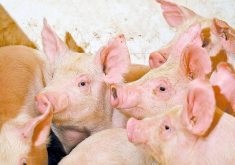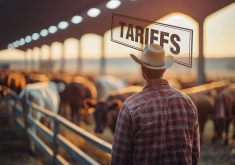Livestock movement tracking is taking a common sense approach by better utilizing Alberta’s livestock manifest.
Livestock Identification Services (LIS), the non-profit, industry-owned company that carries out livestock identification and inspection services in Alberta, is in the final stages of developing and testing an electronic livestock manifest. If all goes as planned, livestock producers will be able to engage in commerce electronically, and track their livestock movement online as early as this summer.
“We’re essentially taking the hard copy livestock manifest and digitalizing it,” said David Moss, LIS’s chief operating officer. “The paper version of the livestock manifest will always be available, but with the eManifest, producers will have options.”
Read Also

Horns aren’t unlocking anytime soon on livestock transport standards
Standards good enough meet the definition of “humane” animal transportation still vary widely between what what industry wants, what animal rights advocates want and, between the two, what federal regulators decide is good enough.
A livestock manifest is a required document to transport livestock within Alberta, and is commonly used in livestock sales.
“In our view, movement tracking, which is a critical component of livestock traceability, should be an outcome of a producer’s daily business of transporting and selling their livestock, not an additional requirement,” said Moss. “Better utilizing the livestock manifest is one example in how this can be accomplished.”
The new system was developed in response to requests from industry, which wants to improve efficiency and maintain data integrity.
“People receiving cattle will have a higher degree of confidence in the correctness and completeness of the livestock information and, specifically, who is to be paid for the livestock,” said Moss.
While the preprinted Alberta Livestock Manifest Books will still be available to those who prefer them, the new system is likely to win many early converts. Users will only have to enter their basic information a single time, and the system’s address book function allows producers, truckers and receivers to easily update each other about a particular shipment’s movement.
“When a producer selects them from an address book, they will automatically be sent the information about the livestock being delivered,” said Moss. “Then when the trucker picks up the animals, he can log on to the site and that information will be sent to both the sender and the receiver. Finally, when the cattle are delivered, confirmation will be forwarded to the sender and the trucker.
“So, everyone gets accurate and up-to-date information as it happens.”
Instant data update
The eManifest system could prove hugely beneficial in a disease outbreak scenario as data is updated instantly. Hard copy manifests take 24 to 48 hours to be inputted into the system and downloaded to the LIS central database.
The system is set up to easily accommodate individual animal tracking, which may prove useful in the future once tag reading becomes a viable option.
“If and when the industry wants to go down that path, this system is an enabler for tag tracking,” said Moss. “The eManifest has been developed to allow producers to attach a tag read file to the movement event. If you had a capable and confident reading system at shipping, you can take a reading from a hand-held or reader, move that information into a file on your laptop or smartphone, and then load that information to the eManifest that is being created for the pending shipment. Very easily, group movement can accommodate individual animal identification.”
A number of producers from all sectors of the industry have offered to help develop and test of the eManifest system. The feedback has been excellent so far, said Moss, with trial participants calling the system easy, user friendly and efficient. That said, LIS won’t roll out the new system until it is certain it is as producer friendly as possible, and relatively glitch free.
“We are doing our best to make the system easy to use and stable,” said Moss.
“We’re working on a very advanced version of the system based on the feedback LIS has received from the trial participants. Then we’ll want a couple more months to test it and make sure we can’t break it, and then we’ll open it to everyone. Security and guaranteed uptime is critical. To ensure this we will be contracting the services of a hosting provider that all producers will know and be comfortable with. We will also be working with Alberta Agriculture and specifically the extension offices to assist with communication and to provide help to producers in using the new system.”
While Alberta’s eManifest system will be the first online, commerce-based livestock manifest system of its type in North America, interest is already high from neighbouring provinces and some U.S. states, he said.
“We need to work nationally on this,” said Moss, adding that LIS is already a member of the Cattle Movement Working Group, an interprovincial body pushing for a national livestock transportation document.
“A disease doesn’t recognize borders, so it is imperative we have a comprehensive data set across the country. We really hope that other provinces will embrace (this technology), as working together builds synergy that cannot be created independently.”














